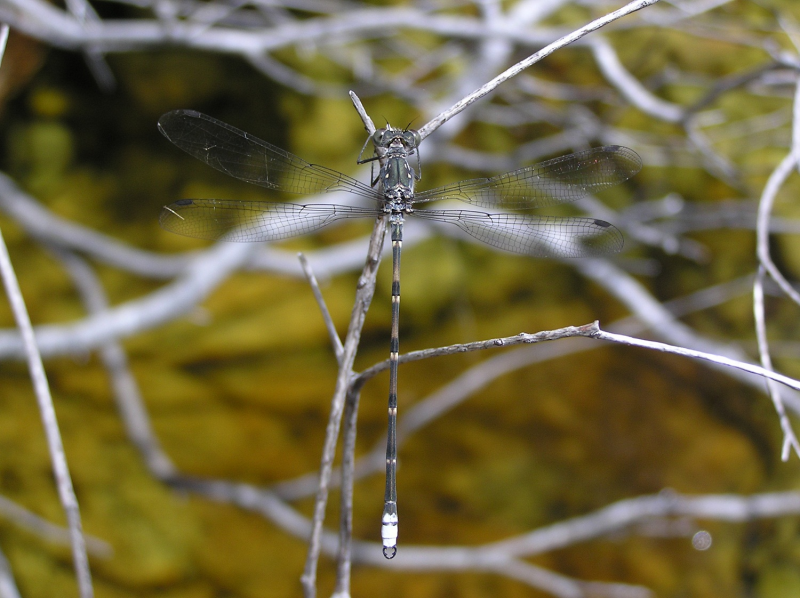View the above photo record (by Felicity Grundlingh) in OdonataMAP here.
Find the Rock Malachite in the FBIS database (Freshwater Biodiversity Information System) here.
Family Synlestidae
Ecchlorolestes peringueyi – ROCK MALACHITE
Identification
Large size
Length up to 52mm; Wingspan attains 65mm.
A distinctive and unmistakable species. More robust than other malachites. This combined with its cryptic, mottled colouration and specialised habitat choice make the Rock Malachite easy to identify.
Closely related to Ecchlorolestes nylephtha (Queen Malachite), but the two species are not known to co-occur.
The sexes are closely similar but males tend to be more slender than females.
Click here for more details on identification.
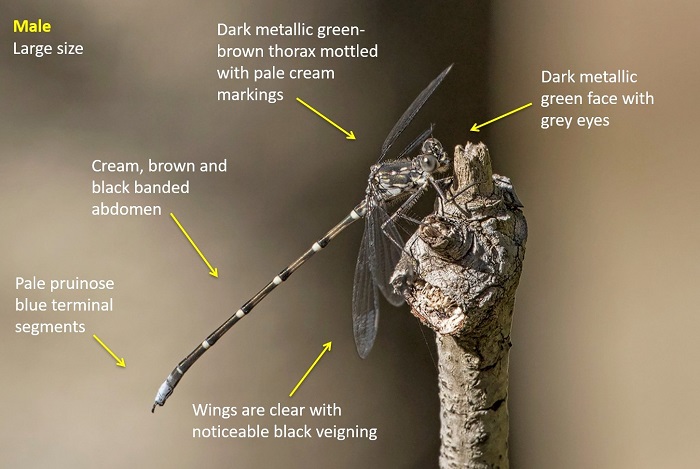
Jonkershoek Nature Reserve, Western Cape
Photo by Desire Darling
Habitat
Restricted to headwater streams and rivers in mountainous terrain. Requires clear, running water with pools and large boulders or exposed rock-faces, festooned with lichen on which to perch.
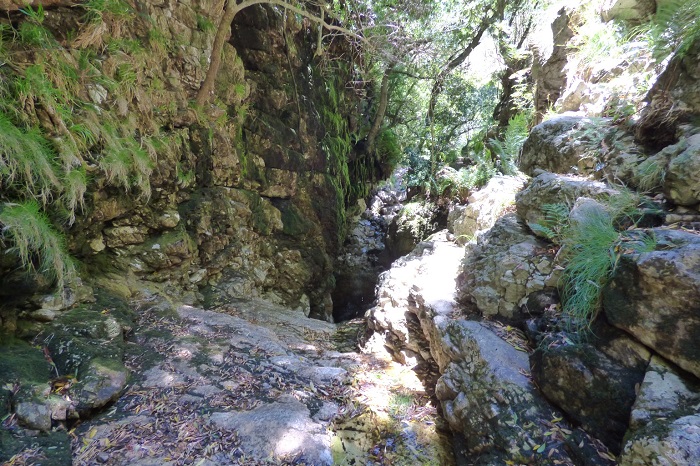
Photo by Corne Rautencach
Behaviour
Well camouflaged and easily overlooked, as it sits against rock surfaces adjacent to streams. Occasionally perches on twigs over the water. Fairly reluctant to fly as it relies on cryptic colouration to avoid detection.
On the wing primarily from February to May (See Phenology below).
Status and Conservation
Uncommon and very localised. Listed as Near Threatened in the IUCN Red List of Threatened Species. The Rock Malachite is not tolerant towards damage to its habitat and only occurs at pristine sites.
Distribution
Endemic to the Western Cape province of South Africa, where it occurs from Kogelberg in the South to the Cedarberg in the North.
Below is a map showing the distribution of records for Rock Malachite in the OdonataMAP database as at February 2020.

The next map below is an imputed map, produced by an interpolation algorithm, which attempts to generate a full distribution map from the partial information in the map above. This map will be improved by the submission of records to the OdonataMAP section of the Virtual Museum.

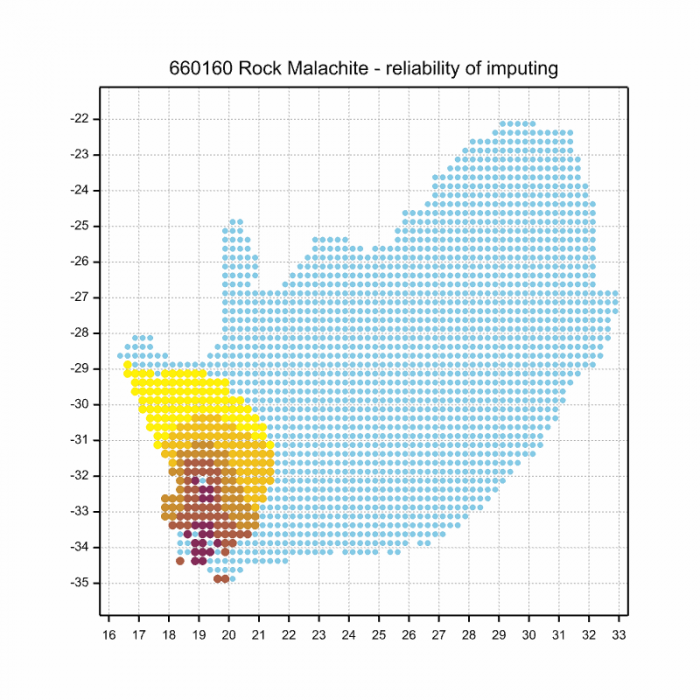
Ultimately, we will produce a series of maps for all the odonata species in the region. The current algorithm is a new algorithm. The objective is mainly to produce “smoothed” maps that could go into a field guide for odonata. This basic version of the algorithm (as mapped above) does not make use of “explanatory variables” (e.g. altitude, terrain roughness, presence of freshwater — we will be producing maps that take these variables into account soon). Currently, it only makes use of the OdonataMAP records for the species being mapped, as well as all the other records of all other species. The basic maps are “optimistic” and will generally show ranges to be larger than what they probably are.
These maps use the data in the OdonataMAP section of the Virtual Museum, and also the database assembled by the previous JRS funded project, which was led by Professor Michael Samways and Dr KD Dijkstra.
The next two graphs shows how the occurrence of Rock Malachites varies within the year, i.e. the phenology. There are only 28 records in the database for this species, so these results need to be treated as tentative. The first plot shows the number of records in each pentade, five-day periods, which start on 1 July and end on 30 June the following year. The maximum number of records in a pentade is five, in mid-March. The blue line is generated by a smoother, an algorithm which aims to separate the “signal” from the “noise”, and shows the pattern of seasonality for this species. The second plot shows only the blue line, and it is scaled to lie between zero and one, for easy comparison between species.

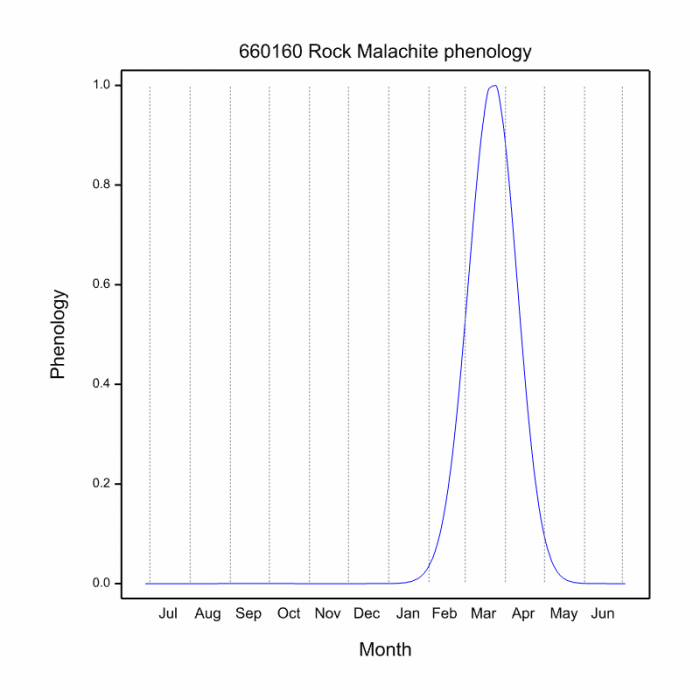
Tentatively (because the sample size is only 28), this phenology plot shows that the Rock Malachite is in flight for a relatively short period in late-summer, from February to April. The peak of the flight period appears to be in March. The peak appears to be quite sharp, but this might be a consequence of the small sample size.
To improve the quality of the phenology, a lot more records of this species are needed.

